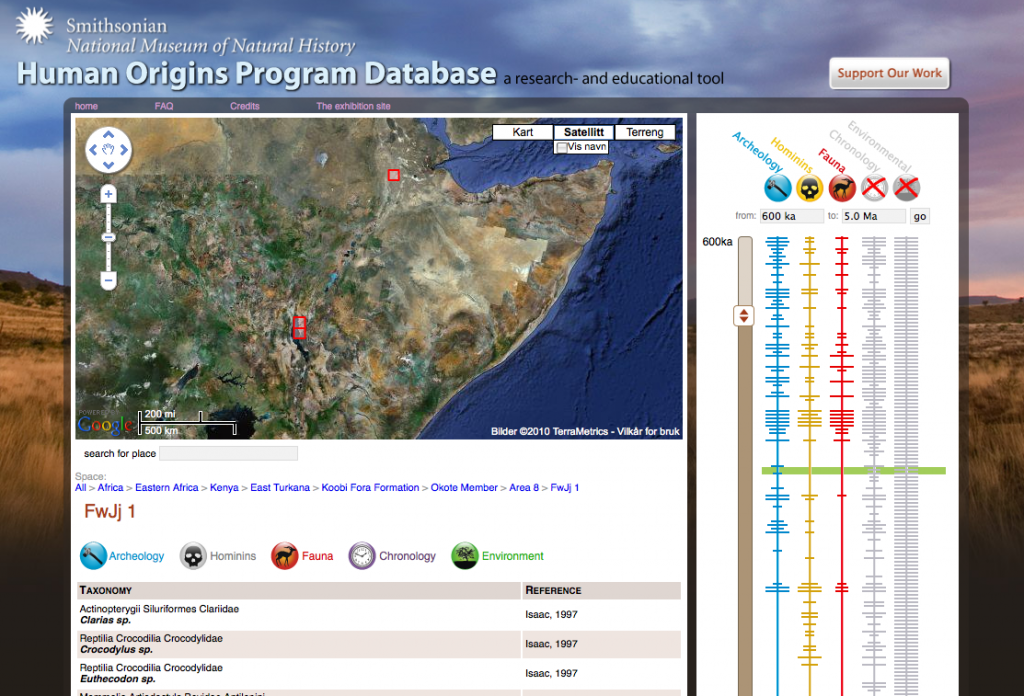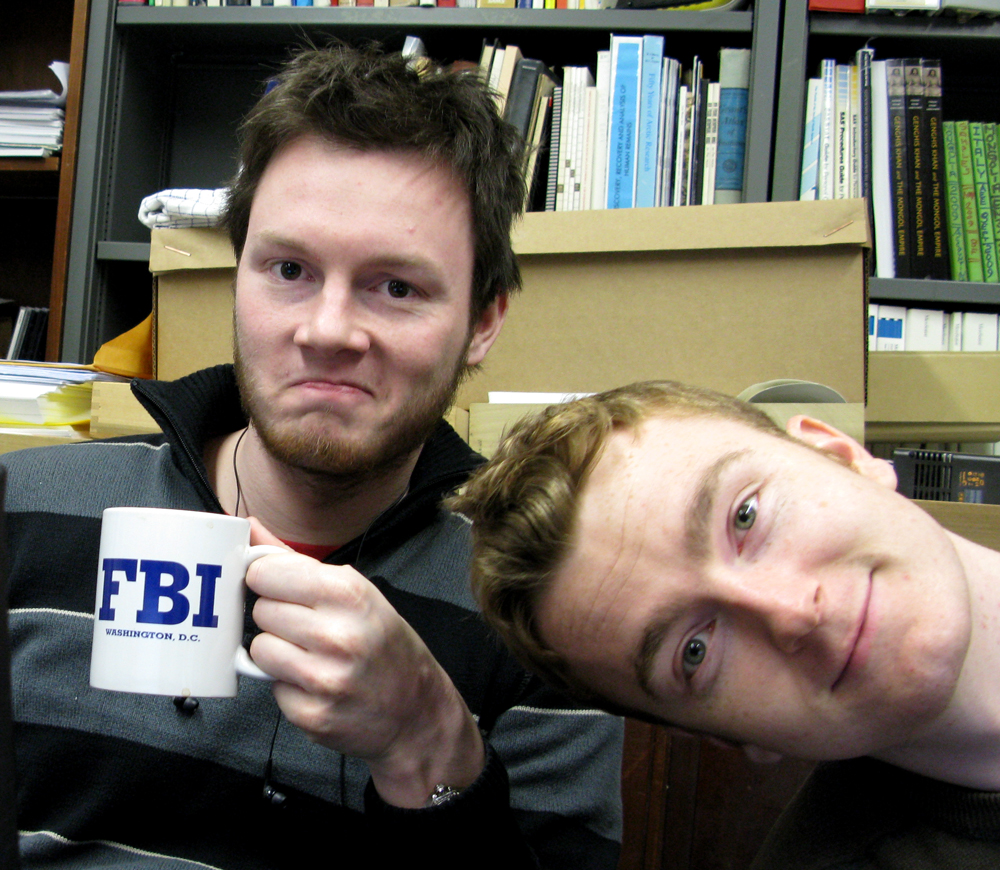bachelor thesis: a walk in the rift valley, four million years ago
So what was that bachelor thesis all about? I have had that question a few times, and now that I have room to breathe again, I will elaborate.
The Smithsonian’s Human Origins Program Database: Relating scientific data through time and space
 At the Smithsonian Museum of Natural History, Washington D.C., they have a programme that’s been going on for a number of years; The Human Origins Program. This is to bring evolution and research out there, mainly via the exhibition Hall of Human Origins. In the US, this is considered politics. I venture to say that in Europe this is considered history. So as the americans need to do sensible research, they also to a certain extent need to step carefully. Interesting, bizarre and a wee bit disturbing to me; this tip-toeing.
At the Smithsonian Museum of Natural History, Washington D.C., they have a programme that’s been going on for a number of years; The Human Origins Program. This is to bring evolution and research out there, mainly via the exhibition Hall of Human Origins. In the US, this is considered politics. I venture to say that in Europe this is considered history. So as the americans need to do sensible research, they also to a certain extent need to step carefully. Interesting, bizarre and a wee bit disturbing to me; this tip-toeing.
Scientists argue. Scientists have specialities, and some are extremely specialised in very detailed, at times small and obscure fields. Sometimes they want to share, sometimes not. Sometimes they dislike other scientists definitions, sometimes the overlap of fields can be enriching or frustrating. They work on projects, and they create the tools they need. It seems that they, for all sorts of reasons, creates their own databases; gather their data and information in forms that suits them best there and then. Not necessarily very sustainable, but if you don’t want to share your findings, well, I suppose you could have it inscribed on scrolls under your bed.
Anyway. Working on The Human Origins Program team is Dr. Matthew Tocheri, a paleoanthropologist specialising in the evolution of the hand and foot. Part of his job is to gather data in a cross-field database. This covers several specialist fields, including paleoanthropology, archeology, vertebrae zoology, geochronology, paleoecology, paleoenvironment and of course geology. He collects data wherever he can find it, from old publications, from fellow researchers. Apparently, it has not been attempted to collect data from these related fields together in this manner before. Matthew collects, and created a database that will accept different definitions, different names and different approaches. This is an exercise in flexibility, and therefore; sustainability.
Understanding that no data is also information.
Everything should be made as simple as possible, but not one bit simpler. – Einstein –
So. In the middle of this, we landed. Two computer engineering students, and one student of digital media. What could we do, and how on earth could we handle those specialist fields?!
The idea was to make a website, that would make it possible to handle these data, show relations and scope quicky and intuitively.
We drew, scribbled, and tried to get our heads around Matthews database. This is complex data with, at times, complex relations. What a field day, for a digital media student! Deep time, deep space…
This is the prototype, as it stands at the end of the project. Google maps, five timelines, and a field for data. It seems simple; it seems obvious, but the road was hard. I like to believe that to make something complex seem effortless is an art; and is the litmus test of a system like this. If you can think “of course, that is how it must be done, it is obvious” – it is the colombus’ egg. It is art, it is magic.
In reality; lots of work.
It is not easy. But it is simple. – House –
We had amazing days in Washington D.C., working with Matthew and the others in the Human Origins Program. (plenty of pictures here) It was relief, and an extreme privilege to work with solid data and talented, smart and dedicated people. The wonderful, beautiful feeling of working with real, sensible content, and not trying to sell sand in Sahara; creating designs and frameworks without content. It was mad, fab and hard work. We spend about six weeks all in all in D.C., and with the exception of one day and a hospitalisation, we worked at the museum every day. Not much sightseeing, not much fresh air. Back in Norway, we did pretty much the same…
There is a million small things to consider, building something like this. Personally, I am primarily interested in the overall structure, the architecture, the interface and the graphic design. To display scope is very important: if you’re looking for information, and you know nothing of the source, it must pretty easily show you that it might contain what you’re looking for or not. This is – as of yet – a site for students and scientists of the fields, and I think I can assume that they have a little more than a two-second attention-span. Still. Scope is absolutely essential.
This is in many ways inf ographics. I do obsess, though, over tiny, tiny details. The amazing privilege of being allowed to do both: play with ideas, overall structures, grand plans and gestures, and at the same time dig into tiny pixels.
ographics. I do obsess, though, over tiny, tiny details. The amazing privilege of being allowed to do both: play with ideas, overall structures, grand plans and gestures, and at the same time dig into tiny pixels.
An example of the detail-obsession, would be the angled text above the timeline icons. I really, really wanted them angled, and the amount of hassle and fiddling to make them, place them, and allow them to be clickable and roll-overs was unreal. Of course, as we kept inventing uses for them, I had to adjust, but it is just one example of obsessive fiddling that would easily have drowned in another project…
..and that brings me to the boys. Lars and Audun handled the programming and database part, while I obsessed with html, css, graphics, interface and structures. Bless them. Not only was it an enormous privilege to work with the anthropologists, but my team was the best. Of course they were, I hand-picked them myself ;-)

Confidence in nonsense is a requirement for the creative process. – M. C. Escher –
That I could fiddle, learn, dig and struggle with things I like, and at the same time important progress was made in other parts, was wonderful. I suspect the boys feel the same. We became a tightly knit team, and we had to talk through definitions and find a common language. We shared the dedication for the project, and nearly worked ourselves into collapse. It was hard, we all had to learn new things ourselves, we all banged fists on the table in frustration at times, but I’d do it all over again. There was plenty of compromises. And plenty of laughs. Ah, the giggles… I will miss that.
But out of the other end, came a prototype we are proud of, that others like and admire, that several people might be interested in, and I believe Matthew is happy with. We got top grades on the project, that I for one feel was the only option. It was not by far the most important thing, but feels good anyway, and the good people at the museum expected nothing less.
At the time of writing, the prototype is hosted on our servers, and only contains some of the data from the database. We hope, though, that it will go live from Smithsonian before x-mas. I am hoping they will continue to develop it; I hope we have been part of pointing out a direction.
Now, as I have finished my bachelor, new adventures beckons. If all goes well, there might be another project for the museum. I keep my fingers crossed, and take a few weeks well deserved holiday. It is summer, and I still have that indoor skin colour that I always thought was the trademark of geeks only…

4 Comments
It is only the beginning
– see you in DC
Meanwhile; I shall care for the motherland.
Godspeed.
[…] against it, mainly because it was unnecessarily large, and the documentation a little shaky for our project. Now, it seems, it works directly with fusion tables… so it […]
[…] was my bachelor thesis, and I describe it in the post Bachelor thesis: a walk in the rift valley four million years ago. […]